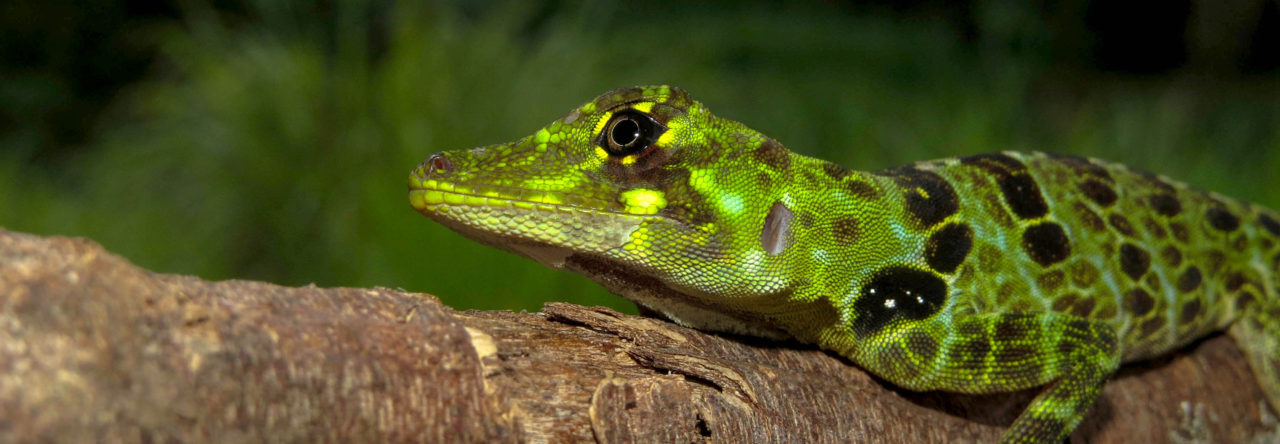
High school students conducting anole research. Read all about it in the author’s post on the paper.
Everyone knows that anoles, like most reptiles, are not good parents. They just drop off the eggs, and that’s that. If they come across their offspring, they might even eat them! Not a paragon of parenthood. But does that mean the anole moms don’t do anything to help their kids? If nothing else, perhaps they could lay their eggs in places that would lead to maximally healthy offspring.
To test this idea, Aaron Reedy and a cast of dozens conducted an experiment in which they gave female brown anoles a choice of nest substrates varying in moisture content to see if they preferentially put eggs in some places over others. Then, they raised the eggs in the different environments to see if it matters.
![]() The results were clearcut: females prefer to lay eggs in the soil with the highest moisture levels available. And, in turn, it matters: eggs put in such soils (the placement of eggs was randomized after the females laid them) had high hatching success, produced large offspring, and led to an overall increase in offspring survival.
The results were clearcut: females prefer to lay eggs in the soil with the highest moisture levels available. And, in turn, it matters: eggs put in such soils (the placement of eggs was randomized after the females laid them) had high hatching success, produced large offspring, and led to an overall increase in offspring survival.
These results are interesting and in agreement with a variety of studies on other reptiles. What is particularly notable about this research is that it was conducted in a low-income neighborhood city high school science classroom. The first author, Aaron Reedy, was a science teacher (he’s now in grad school at the University of Virginia), and the project was conducted by him and a large number of his high school students. Now, that’s remarkable! Reedy provides an interesting account of how the experiment came to be and what the students thought of it in a post at Scientific American’s website.
This paper also brought to our attention another paper published earlier this year that had eluded AA‘s notice. Dan Warner, the last author on the Reedy et al. paper, was the first author on a paper in Biological Journal of Linnean Society earlier this year that investigated the effect of temperature and moisture levels on brown anole incubation success. Overall, the authors found that temperature had more of an effect than moisture levels, and they also concluded that the differences produced among the offspring were not of great magnitude. These results seem somewhat at odds with the Reedy et al. paper, but the Warner et al. provided a smaller difference in soil moisture between treatments, which may explain the discrepancy. In any case, here are the conclusions of the Warner et al. paper: “…hydric and thermal conditions experienced during development can greatly impact rates of development and offspring size, and some phenotypic effects might depend on maternal egg investment (egg size). However, because of the minor differences among treatments, the biological significance these short-term phenotypic effects are likely small. Because morphological adaptation to local habitats has been critical in the radiation of Anolis lizards (Losos, 2009), our findings are important as they partially rule out the developmental environment as a source of substantial morphological variation (at least in A. sagrei). For example, although limb morphology is influenced by incubation temperature in other lizard species (Braña & Ji, 2000; but see Warner & Shine, 2005), temperature does not seem to be an important source of variation in A. sagrei.”
Aaron M. Reedy, David Zaragoza, and Daniel A. Warner (2012). Maternally chosen nest sites positively affect multiple components of offspring fitness in a lizard Behavioral Ecology DOI: 10.1093/beheco/ars133
DANIEL A. WARNER, MELISSA A. MOODY, RORY S. TELEMECO and JASON J. KOLBE (2012). Egg environments have large effects on embryonic development, but have minimal consequences for hatchling phenotypes in an invasive lizard Biological Journal of the Linnean Society, 105, 25-41 DOI: 10.1111/j.1095-8312.2011.01778.x
- Evolution in Real Time on Lizard Island - March 23, 2025
- Spider Snags Adult Anolis osa - March 22, 2025
- An Homage to the Green Anoles of New Orleans - March 21, 2025


2 Pingbacks